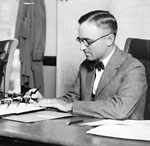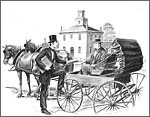Run, Judge, Run
Would Somebody Please Give the Honorable a Campaign Button?
By F. S. Naiden
If you’ve ever appealed a parking ticket, not to mention any costlier legal business, you may have been unamused to learn that most judges are elected officials. Yes, you voted for the gent or lady who fined, garnished, or jailed you. You can even collect his or her election campaign memorabilia, and that of other judges going back to the 18th century. Mountains of posters, broadsides, banners, buttons, sheet music, cartoons, pamphlets, bumper stickers, and palm cards are for sale at printsoldandrare.com and oldpoliticals.com. Pick the party, state, or county you blame the most, and you can compare the throw-away efforts of judicial candidates to secure the votes of those whom they harm or disappoint as often as they help. Or pick a political hero of yours. He likely ran for a judicial office. Andrew Jackson and Harry Truman were elected judges. Abraham Lincoln served as a substitute for a judge, David Davis. Lincoln repaid Davis by nominating him to the US Supreme Court in 1862. The Senate confirmed him by a voice vote. If anyone voted “nay,” there is no record of it.
That’s been the trouble for President Obama’s Supreme Court nominee, Sonia Sotomayor. Like David Davis, she is not elected, but rather confirmed by the Senate. Yet the Senate is not what it was in the less contentious times of the American Civil War. Today there is a record of each Senator’s vote, preceded by hearings and debates in which most Senators speak. To be sure, there is no election—that would be unconstitutional. Yet Supreme Court nominees have to run for the office just the same. A party leader, the President, picks them. Then they must put themselves in the hands of White House managers who direct the campaign to get them confirmed. And finally, they must elicit statements of support from important voters (that’s where the Senators come in). The statements of the candidate are something any pretzel maker would envy. They start with what the candidate has already said, end with what the Senate wants to hear, and in between are either truthful or deceitful—even the candidate can’t always tell which.
Any political hero of yours likely ran for a judicial office.
How much more natural this candidate was before she became a candidate! When Sotomayor told a Berkeley audience that Latina women could judge more wisely than white men, she was reminding possible supporters that she was available. When she told them that appellate courts make laws, and don’t interpret them, she was reminding them that she was not only available, but ready. Saying this with a smile—Ronald Reagan would have admired her delivery, and so would Bill Clinton.
Supreme Court candidates need campaign buttons. They need campaign songs and tickertape parades down Pennsylvania Avenue. They need TV ads, too, dignified and soft-focus: parade clips, quotes from newspaper editorials, a shot hugging Mom. Then the rest of the voters, the American electorate, will not feel overlooked. The candidate will be free to do what candidates do best, praise the people, and to avoid what all candidates do worst, discuss hypothetical lawsuits in front of C-SPAN cameras. The Senate can follow the opinion polls about the nominee, and vote accordingly. Every senator who wants to defy an opinion poll and vote no can be paired with a senator who wants to defy an opinion poll and vote aye. (Paired voting is nothing new. The Senate already allows paired voting on Supreme Court nominees.)
It would be good for the button business. Remember, judge, times are hard.









